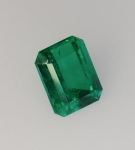Emerald Information and Background
Emerald: The Green Treasure
"Indeed there is no stone, the color of which is more delightful to the eye; for whereas the sight fixes itself with avidity upon the green grass and the foliage of the trees, we have all the more pleasure in looking upon the smaragdus, there being no green in existence of a more intense colour than this. And then, besides, of all the precious stones, this is the only one that feeds the sight without satiating it.
Even when the vision has been fatigued with intently viewing other objects, it is refreshed by being turned upon this stone; and lapidaries know of nothing that is more gratefully soothing to the eyes, its soft green tints being wonderfully adapted for assuaging lassitude, when felt in those organs" the Natural History Book- Book XXXVII. (The Natural History of Precious Stones, Chapter 16. Pliny the Elder (23-79))
His real name was Gaius Plinius Secundus. He was an ancient Roman soldier, author, and a philosopher who had an insatiable curiosity about everything including the natural order of things. He was also known as a master researcher because of his extensive work in compiling information from earlier writers and philosophers.
Besides his own treatises on history he also wrote a whole book on nature which included a number of chapters about gems and precious stones. .Smaragdus. is a term that refers to a whole range of green gems including emeralds. However, the reader can be pretty certain that he is describing an emerald when he talks about the incursions that are associated with emeralds, and also when he describes the deep green of the treasure.
Pliny was born into a prosperous family in Gaul, and educated in
Then he lived in
His last official assignment was at the
Pliny also discussed the flaws or defects that were found in the Smaragdus. Flaws or what is known technically as "inclusions". is one sign of an emerald and one of the traits that often makes the stone identifiable as a true gem.
Today, some of the finest emeralds can be found in
Making your own Emeralds?
Genuine emeralds are very expensive, and not available to the casual collector. However, with todays technology scientists can make lab-created emeralds that can be sold at affordable prices on the open market. They are made by exposing thin slices of natural beryl to a chemical mixture that is akin to an authentic emerald. The mixture is one of pure filtered water and acids.
Then it is put under intense heat in saline solution. Then the stone slices cool until crystal forms and it reaches a gem like thickness. When this process is complete it can be cut and processed like a gem.
lusions or flaws in a stone can have an effect on its value, so the flaws do lower the market price.
He gathered most of his information on inclusions from the works of earlier writers. The emerald comes from the beryl family of precious stones. Its beautiful green color comes from the traces of chromium and iron in the rock. Emeralds do come in various shades of green and bluish green.
The dictionary definition of an emerald is: 1. a rare variety of the mineral beryl that is green because of its chromium content and is valued as a gem. 2. clear, deep green. The colour intensity of an emerald depends on the chromium quantities. Maytime Grass is considered to be the most beautiful. An emerald is one of the few stones that actually will shine in the dark when a small amount of light appears in the room.
The colour occurs when the geochemical makeup of beryllium and chromium are found together. The combination is not easily found, and considered to be a rare phenomenon. Natural chemical processes are what really form the stones.
Emeralds are hard but are sensitive and prey to flaws or inclusions. They require a lot more care than most other gemstones. The flaws occur through the trials imposed by nature, and sometimes the engineering process developed by man. The identification of fissures, however, does serve a useful purpose.
The flaws help to weed out artificial emeralds from the real ones. Inclusions actually prove an emeralds authenticity. Refraction and density of the stones vary from the location where they are found. Emeralds are found buried in their parent rock.
